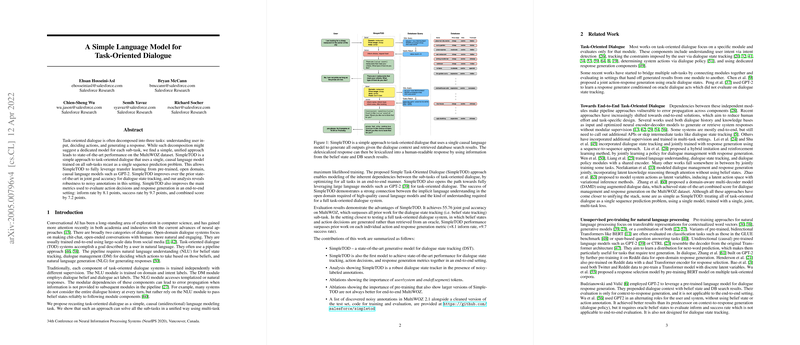A Simple LLM for Task-Oriented Dialogue
The paper "A Simple LLM for Task-Oriented Dialogue" presents an innovative approach to streamlining task-oriented dialogue (TOD) systems by using a single causal LLM, named SimpleTOD. This methodology recasts TOD as a sequence prediction problem, leveraging transfer learning from pre-trained LLMs like GPT-2. The aim is to unify the traditionally modularized structure of TOD systems, encompassing natural language understanding, dialogue management, and natural response generation, into an end-to-end framework.
Key Contributions
- Unified Model Framework: SimpleTOD treats the entire task-oriented dialogue as a single sequence prediction problem. This approach eliminates the need for a pipeline structure, addressing issues such as error propagation across modular components.
- Utilization of Pre-trained Models: By reformulating TOD tasks, SimpleTOD takes advantage of pre-trained LLMs. This efficiently transfers language understanding from large corpora gathered in open-domain settings.
- Performance and Robustness: On the MultiWOZ dataset, SimpleTOD achieves a state-of-the-art joint goal accuracy of 55.76 for dialogue state tracking and enhances action and response generation metrics with inform rate, success rate, and combined scores surpassing prior models.
- Evaluation and Analysis: The paper offers an in-depth analysis of SimpleTOD's resilience to noisy annotations in the dataset, as well as ablations that highlight the importance of tokenization and pre-training in achieving optimal performance.
Methodology
SimpleTOD integrates all sub-tasks—dialogue state tracking, action decision-making, and response generation—into a single model trained end-to-end. During inference, the model treats user inputs, context, belief states, database results, actions, and responses as parts of one continuous input sequence. This causal framework fully exploits the LLM's capabilities to maintain coherent dialogue across different domains and tasks.
Results and Implications
The paper presents numerical results demonstrating that SimpleTOD improves key metrics over previous state-of-the-art models: it achieves an 8.1 point increase in inform rate and a 9.7 point increase in success rate. These improvements indicate better task completion and reliability in presented information, enhancing user interaction quality.
Future Developments
The implications of this research are multifaceted. From a theoretical perspective, it provides a seamless approach to task-oriented dialogue, fostering further exploration into sequence prediction models for complex AI systems. Practically, the simplicity of this model suggests a reduction in computational resources and development time for dialogue systems, which can lead to more efficient and scalable implementations.
Overall, the paper affirms the potential for pre-trained LLMs to transform dialogue systems, offering insights into constructing more unified and robust conversational agents. The work encourages future investigations into simplifying other areas of natural language processing through similar methodologies.
Conclusion
"A Simple LLM for Task-Oriented Dialogue" provides a comprehensive framework that captures the complexity of conversational AI tasks in an elegantly simple model. By highlighting the interconnectedness of dialogue sub-tasks and utilizing the latent capabilities of large pre-trained models, it paves the way for both refined performance and enhanced usability in task-driven dialogues.
